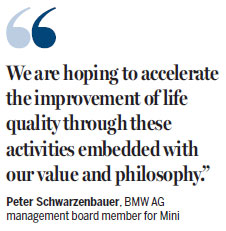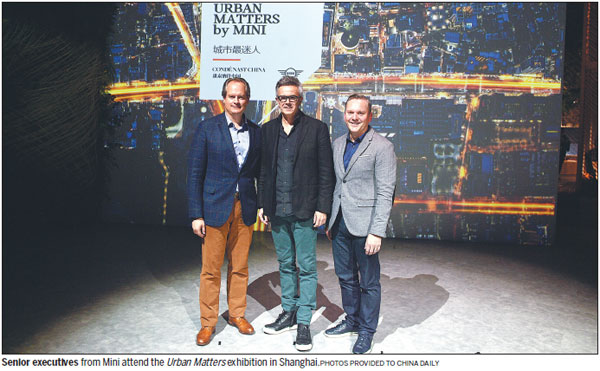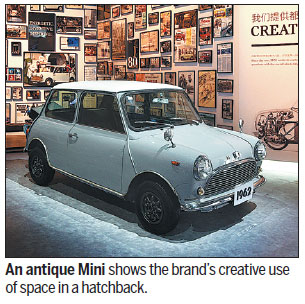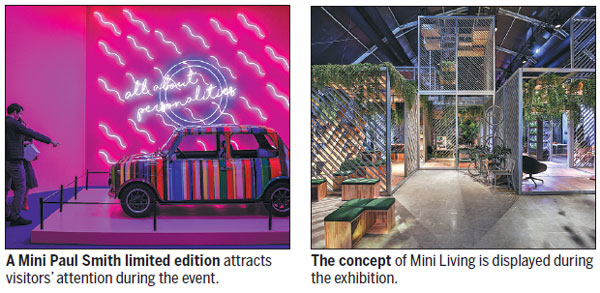Mini Living's 'creative use of space' could reinvent urban housing
Born with "creative use of space" at its core, Mini, the British automobile brand of BMW Group, announced on Saturday that Shanghai will be the first place to embrace its Mini Living concept.
Tackling the most pressing challenges of urban living, Mini Living offers a modern shared-living concept as a potential solution to the shortage of attractive and affordable urban housing. The concept will later expand to New York, Munich and Berlin.
"There are two challenges in city lifestyles: mobility and living space. Mini is trying to bring them together. Occupants in a Mini Living building are close together, and you won't need your own car," Peter Schwarzenbauer, BMW AG management board member for Mini, Rolls-Royce, BMW Motorrad, Customer Experience and Digital Business Innovation, told China Daily.

"We are hoping to accelerate the improvement of life quality through these activities embedded with our value and philosophy," he added.
Co-living buildings
The company displayed its innovative Mini Living installation at its Urban Matters by Mini exhibition in Shanghai.
The installation centers on an apartment that forms part of a micro-neighborhood of similar living spaces, with fold-out shelving modules forming the apartment's walls.
Schwarzenbauer said: "We selected Shanghai for two reasons: the speed of implementation and the specific target group. Shanghai is working extremely fast to get things done. Urbanization is seen everywhere in Shanghai and we find significant changes every day."
"The philosophy for Mini Living buildings will be consistent globally and the principles will be the same.
"The occupants will find basically the same environment. People change a city, but will not change their home," said Schwarzenbauer.
Mini Living turns sharing into an adventure in its own right. Occupants who make their working and functional spaces sharable with the wider community can quite literally "open up" to interaction and experiences that would not be possible in a conventional private space.
At the concept and design stage, Mini was already able to put into practice the central principle behind this installation - that "sharing means more for everyone".
Schwarzenbauer said: "The Mini Living building will be an open space not only for the occupants, but also something for people not living in the building."
Today, finding attractive and affordable living space is one of the biggest urban challenges for young people or families just starting out in life. Mini's answer is the creative use of space.
Mini Living applies the brand's essence to further areas of urban life unconnected with the automobile.
The emphasis is on squeezing the maximum potential from the smallest possible physical footprint.
Integrated into these modules are a variety of features and systems, such as a kitchen unit, a workbench and a music system. The wall-forming shelves can be opened out to offer shared access to the apartment's various objects and functions.
By opening out the different shelves, the apartment's interior space can be reconfigured in many different ways, providing the appropriate backdrop for all sorts of spontaneous activities and unique experiences. Folding out the kitchenette and music system creates the perfect setup for a spur-of-the-moment kitchen party.
Mini Living takes the Mini brand's original mission to the next stage: improving the quality of urban life.
"After our Mini Living building is completed in Shanghai, I believe it will attract many visitors from around the globe to experience the shared living space," Schwarzenbauer said.
Continuous success
Mini is an urban brand that proactively inspires new possibilities for more intelligent and globalized modern city life. It is more than just a small-size vehicle, but also an icon of an independent state of mind.
Among the most valuable brands worldwide surveyed by Interbrand, Mini ranked No 87 this year with a brand value of $5 billion.
The company's development strategy to forge Mini Living and Mini Fashion centers on the Mini automobile manufacturing business, which has refreshed its sales record in the first nine months this year.
In January to September, a total of 271,394 Minis were delivered to customers globally, 2.8 percent more than in the same period in 2016. China registered an 8.9 percent year-on-year jump in its sales volume in the first nine months, with 25,002 Minis sold across the country.
"Mini China will play a bigger role in the next year and contribute a much bigger part to the global sales volume," said Schwarzenbauer.
haoyan@chinadaily.com.cn



(China Daily 11/02/2017 page7)














